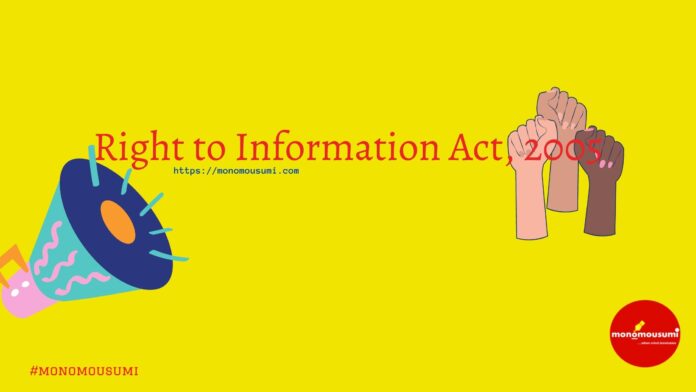The trio of informational lacuna, social leniency and prosecution difficulty
Weave the culture of corruption that is gloomy.
RTI has come with its sword of institutionalization, accountability and transparency
To defeat the enemy of bribery, embezzlement and secrecy.
Focusing on citizen rather than state in model of development
RTI bristles its citizens with awareness, activeness and empowerment.
Years back in 2005, a rainbow in form of Right to Information (RTI) Act was introduced in India amidst the clouds of secrecy, ambiguity and unaccountability- the three harbingers of corruption. Empowering citizens by allowing them to seek information regarding government functioning, RTI fostering transparency and accessibility of information act as a torchbearer in the darkness prevailing around due to sinister interests and evil tendencies. It had and continues to have a tremendous impact on social life of individuals and make their lives turn over a new leaf.
What is RTI?
Replacing the erstwhile Freedom of Information Act, 2002, Parliament of India enacted Right to Information Act which came into force on 12 October 2005. It set out a practical regime of right to information for citizens, deepened democracy and introduced an element of good governance. Under this act, any citizen of India may request information from a public authority which is required to reply expeditiously. It provides citizen access to information; inspect works, documents or records; take notes, extracts or certified copies of documents and obtain information in form of diskettes, print-outs or electronic mode. It even empowers citizens to make complaints in case of rejection, refusal, incomplete information or delayed response to their appeal.
Evolution of RTI
Rome was not built in a single day and so was not RTI. This introduction of RTI was not a single day event but a consequence of the struggle going on both at domestic and international level. The realization of importance and value of accessibility to information on a global scale led to evolution of right to information centuries back. The first ever RTI law was enacted in 1766 and it was in Sweden where this revolution began. This led to a wave of fostering transparency and empowerment that struck the shores of numerous countries. Swedish example was followed by US, Norway, France, Netherlands, Australia, New Zealand, Canada, Denmark, Greece, Austria and Italy.
By 1990 around 13 countries had enacted Freedom of Information (FOI) laws. A leap was taken in this direction when in 2000 European Union Charter of Fundamental Rights included freedom of expression and right of access to documents in these laws. By 2010, national-level RTI laws were enacted in more than 85 countries.
In India, demand for right to information came up on the eve of 1977 Lok Sabha election after the internal emergency of 1975-77 when there was suppression of information, abuse of authority and press censorship. As a result in 1977 Morarji Desai constituted a working group to review Official Secrets Act, 1923 to enable greater flow of information to public. However, the working group shut the doors to transparency and openness by bringing a ‘no change’ recommendation. Realizing that freedom of speech and expression provided under article 19 of Indian constitution is incomplete without right to information, the Supreme Court in famous case of L.K. Koolwal v/s State Of Rajasthan And Ors, 1986 stated that right to information is implicit in freedom of speech and expression.
The commitment to right to information was again renewed by National Front Government in 1989 due to increasing frustration of people over the earlier government’s reluctance to reveal information relating to Bofors and other deals. However this commitment, due to early fall of government, was just in words and not in action, so there was no headway towards transparency and openness in governmental functioning.
In 1994, a campaign was started for Right to Information by Mazdoor Kisan Shakti Sanghathan, an organization for worker’s rights, demanding information regarding development works in rural Rajasthan. As a result a law on Right to information was enacted by Rajasthan government in 2000.
In 1996, National Campaign for People’s Right to Information was founded with the objective to get legislation on RTI passed. Tamil Nadu in 1997 became the first Indian state to pass a law on Right to Information. Then in 2000, Freedom of Information Bill was introduced by National Democratic Alliance which after being pending for about 2 years was finally passed in 2002 and it received the assent of President of India on 6th January 2003.
In 2004, National Advisory Council which was appointed by UPA government to review implementation of government policies recommended changes to the existing Freedom of Information Act, 2002. In 2004, RTI bill was tabled in Parliament which after 150 amendments was passed in 2005 as RIGHT TO INFORMATION ACT.
RTI – A mechanism to induce social change
The institutional change in form of RTI Act turned the social life over new leaf. It not only ensures accountability but facilitates people’s participation. This enables people to effectively debate on government policies and make informed choices during elections. This will lead to strengthening of administrative decision- making power. It enhances people’s capacity to exercise their rights and fight for their interests. It enables citizen to raise their voice against any ill- practice, injustice and discrimination. It enables people to maintain a check on government actions. The access to information leads to improved decision making and better allocation of resources which results in greater economic and social well- being of people.
It is the institutional change that can bristle environment with transparency and accessibility of information, make governmental affairs much more open to public and help foster accountability, efficiency as well as reduce corruption. RTI has enormous potential through stricter enforcement of norms of ‘pro-active disclosure’ as well as mandatory penalties in event of non- compliance. It is the source of fresh air and sunshine in the stifling and dark atmosphere of governance. It is a tool to bring paradigm shift from state centric to citizen centric model of development that is responsive, efficient and responsible.
By discouraging arbitrariness in administration and reducing chance of abuse of authority by public servants, RTI results in better delivery of goods and services to people by civil servants; encourages intelligent and constructive criticism of administration and promotes public interest.
The efficacy of RTI is revealed by the numerous successes in its use by individuals and citizen groups to seek information on government schemes, development projects, benefits and entitlements. Numerous infamous scams and deep- rooted grafts have been exposed with the help of RTI. RTI by Sabar Ekta Manch, an NGO in Gujarat regarding audits of MGNREGS has helped expose corruption in wage payments and construction projects. It has been used by groups such as Parivartan for enforcing public work contracts and by SNS (Satark Nagarik Sangathan) for helping the poor to access their basic rights and entitlements to ration cards, pensions, electricity connections, sanitation, education etc. The organizations like Housing and Land Rights Network used RTI to expose instances of poor administration in form of diversion of social security funds to pay for 2010 Commonwealth Games.
Adarsh Housing Society scam, 2G scam, Commonwealth games scam have been revealed by RTI. The irregularities by the Public Distribution System in Assam in the distribution of food meant for people living below the poverty line were revealed by RTI filed by an NGO named Krishak Mukti Sangram Samiti. Another RTI application filed by a Punjab-based NGO highlighted that heads of the local branches of the Indian Red Cross Society had diverted money intended for the victims of the Kargil war and natural disasters. There are numerous other instances where RTI has helped to throw light on ills going on in the functioning of government.
Inadequacies reducing shimmer of RTI
RTI is a powerful tool but it suffers from certain shortcomings. Stakeholders remain oblivious to their rights and obligations under RTI act. Poor record management and lack of sufficient budget, manpower and infrastructure hampers the functioning of RTI. Public information officers pass non- reasoned orders; do not adhere to timelines prescribed under the act; provides vague, incomplete and misleading information. Numerous applications are filed by a single applicant on same subject matter which causes disproportionate diversion of resources of public authorities. Vacancies in Central Information Commission are leading to huge backlog of appeals and complaints resulting in inordinate delays which render the law meaningless for citizens. The attack, murder, physical and mental harassment of those trying to seek information under RTI is another cause of concern.
Let’s leave no stone unturned
The issues crippling RTI need to be addressed at the earliest to tap the potential of RTI by raising awareness about benefits of RTI, filling vacancies, providing protection to those seeking information under the act and bringing laws to make Public Information Officers answerable for failing in their duties into effect in true spirit.
RTI is a potential instrument of change. To make it more effective it is necessary to repeal Official Secrets Act; bring bodies substantially funded by government within ambit of RTI and set up a National Co-ordination committee. Further not only Public Information Officers (PIO) but also civil servants need to be trained in respect of RTI. Awareness campaigns need to be entrusted to credible non- profit organizations. A Public Record office needs to be set up as an independent authority in Government of India and the states to serve as a repository of technical expertise in management of public records. Also the mechanism to access to information needs to be made lively by setting up four regional offices of Central Information Commission; organizations having more than one PIO should designate a nodal PIO; a single window agency in districts should be setup to receive request on behalf of all PIOs in the district and payment process should be made more flexible through stamps or even postal address.
Winding up
Access to information can be a useful tool in improving societies but it is not a magic wand that can cure all social ills and bring radical transformation. A law for right to information can only come up in flying colors with active participation of people. Thus it imposes a responsibility on citizens of a democratic society to obtain and use the information for social benefits and not private interests. The right to information should not become a tool of right to injustice.
India is handcuffed by poverty, hunger, illiteracy, unemployment, terrorism, climate change and cherry on the cake of problems is corruption, lack of transparency and accountability. Corruption has become an endemic feature of Indian administration and commercial life that nothing moves in intended direction unless the palm of the deliverer is greased. The depth of roots of corruption can accurately be measured by India’s 80th rank in CORRUPTION PERCEPTION INDEX by TRANSPARENCY INTERNATIONAL and 77th in TRACE Bribery Risk Matrix 2020. There is not just the neglect of duties but temptation for officials to deliver at high prices what they are actually supposed to deliver free as part of their job. The seeds of corruption nurture and foster due to availability of informational darkness, a social environment that tolerates misdeeds and lack of threat of prosecutions and sanctions. Thus, introduction of tools like RTI can help it to cut the roots of the monster of corruption and build a relationship of trust and checks & balance between government and citizens.
In the long run
The information that is available and accessible
Makes the governance transparent and accountable
Makes people aware, enlightened and empowered
Brings in active participation of all that is desired.
By DEEPIKA SINGLA, HARYANA
















